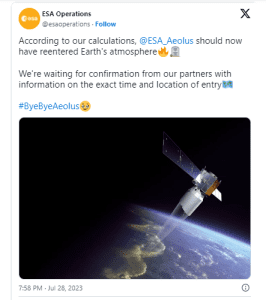In a first-of-its-kind mission, a British-built weather-monitoring spacecraft was deliberately crashed into the Atlantic Ocean.
The European Space Agency (ESA) successfully guided Aeolus, a satellite that has provided crucial data to weather stations around Europe since 2018, to its last resting place.
The ESA’s Space Debris Office announced it had entered the atmosphere at 7 p.m. UK time on Friday, making it the first time a deceased satellite has been steered to execute an assisted crash on Earth.

Aeolus would normally fall back to Earth, burning up in the planet’s atmosphere after reaching an altitude of roughly 50 miles.
The ESA’s simulations before the crash revealed that some debris may have survived the burn, however the risk of causing any harm was low.
Instead, the space agency chose to utilize the remaining fuel to guide Aeolus down to Earth.
It also intends to gather data for future satellite re-entries while setting a precedent for nations and organisations to follow suit.
The ESA said: “The Aeolus mission control team in Germany is now wrapping up after a long week of complex operations.
“They have done everything they planned in what is a first-of-its-kind assisted re-entry. Aeolus – a mission that revolutionised wind profiling – is now out of their hands.”
The 1,360kg Aeolus spacecraft was built by Airbus Defence and Space in Stevenage and is the first satellite mission to acquire profiles of Earth’s wind on a global scale.
Aeolus was slated to last three years but it outlasted its mission by nearly two years.
The spacecraft had been falling from its operational altitude since June 19 and performed its first major re-entry maneuver on July 24.





